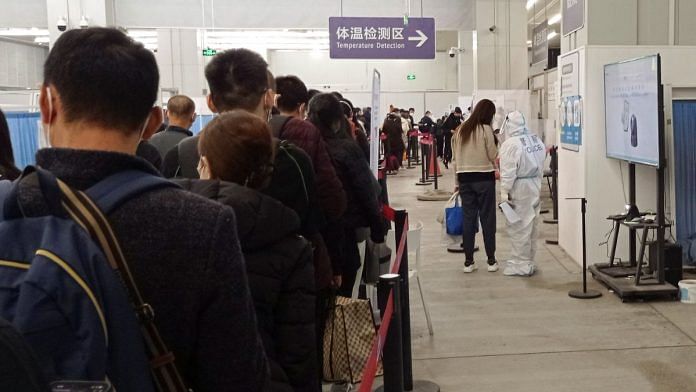New Delhi: Since abandoning its strict ‘zero-Covid’ policy last month, the death-toll in China has exploded with nearly 60,000 people in the country dying of Covid since early December. Earlier, on 20 November, the country had reported deaths of three people as the first few in six months.
As per international news agency AFP, the National Health Commission in China Saturday said that 5,503 more people died in December due to respiratory failure caused by the virus and another 54,435 died due to other ailments combined with Covid. The official number stood at 5,272 till 8 January.
According to the now narrowed-down definition of Covid fatalities in China, though, only the 5,503 people who died of respiratory failure will be marked as Covid deaths.
The Commission also stated that these are just deaths counted in hospitals, indicating that the toll might be higher if numbers of those who might have succumbed to Covid at home are included.
Still, the latest figures have almost doubled China’s death score since early December to 10,775.
This also comes at a time when studies are predicting that Covid death toll in China is set to cross a million.
US-based Institute of Health Metrics and Evaluation (IHME) has projected that over a million people in the country could die of the virus through the year 2023, with cases peaking around 1 April, when deaths would reach 322,000.
About a third of China’s population will have been infected by then, the study added.
Following what is being seen by the international community as another Covid wave — the biggest so far — there’s a clamour worldwide for the Chinese government to share more data.
The World Health Organisation (WHO) Sunday asked China to share more data on the outbreak.
“Reliable and current data allows for a better understanding of epidemiological situations,” the organisation said, stressing that such data should be shared with them as well as citizens.
The government had stopped reporting Covid data since 8 January, causing international concerns that lack of transparency in sharing data may be masking the true impact of the country’s massive outbreak. The concerns were exacerbated by the country’s decision to lift almost all of its hardline Covid restrictions in early December following protests by citizens over the ‘zero-Covid’ policy.
Disease modelers at the University of Hong Kong have predicted that lifting Covid restrictions and simultaneously reopening all provinces may result in 684 deaths per million people between December 2022 and January 2023. Their paper, however, is yet to be peer reviewed.
Also read: China finally releases Covid data but citizens don’t believe it’s just 60,000 deaths
China’s ‘zero-Covid’ & vaccination policies
As per China’s zero-Covid policy, the country had stated that its goal in fighting Covid was to keep the number of cases as close to zero as possible. In order to achieve this, it implemented mass testing, quarantined the sick in government facilities and imposed strict lockdowns.
When these restrictions were lifted, Beijing admitted the scale of the outbreak meant that numbers were now impossible to track. Compare this to its stance on 21 and 22 December last year when it reported zero Covid deaths.
“At present, Covid-19 prevention and control in China are facing a new situation and new tasks,” said Chinese President Xi Jinping in a directive in December, according to state broadcaster CCTV.
“We should launch the patriotic health campaign in a more targeted way… fortify a community line of defence for epidemic prevention and control, and effectively protect people’s lives, safety and health,” he added.
China’s elderly population is disproportionately vaccinated. Of the 90 per cent of the country’s population that is vaccinated, only about 69 per cent above the age of 60 have received over three doses. Of these, only about 40 per cent above the age of 80 have taken three doses.
Vaccination is not mandatory in China and previous efforts to enforce restrictions on those unvaccinated have failed to work.
Also read: China braces for Covid holiday surge as people leave megacities for hometowns






